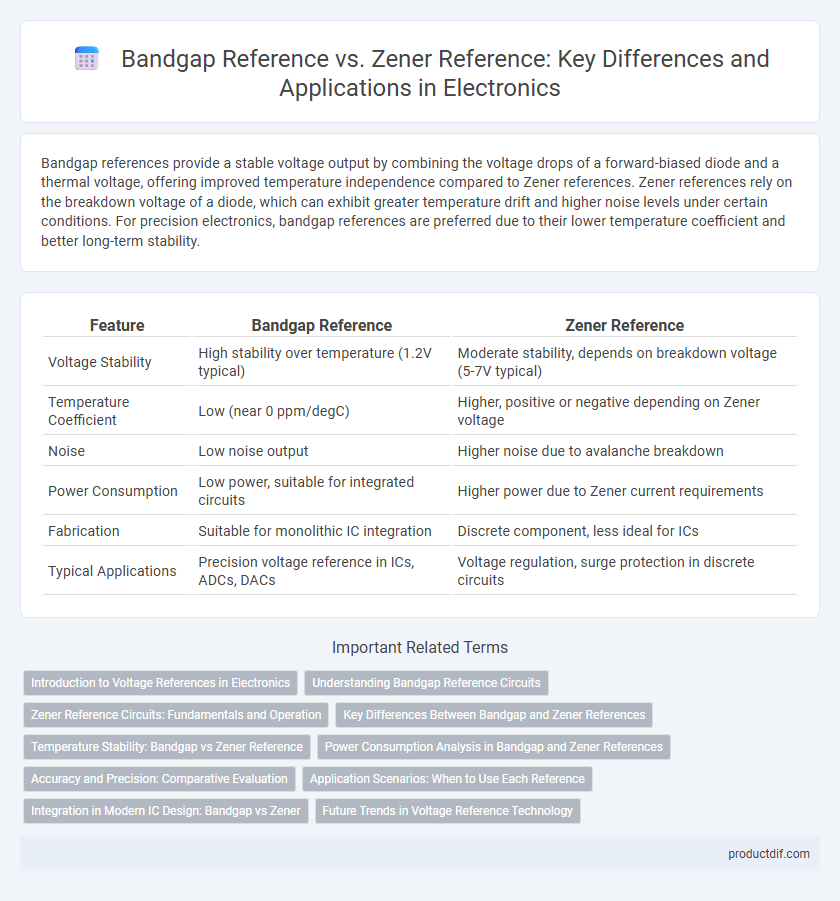Bandgap references provide a stable voltage output by combining the voltage drops of a forward-biased diode and a thermal voltage, offering improved temperature independence compared to Zener references. Zener references rely on the breakdown voltage of a diode, which can exhibit greater temperature drift and higher noise levels under certain conditions. For precision electronics, bandgap references are preferred due to their lower temperature coefficient and better long-term stability.
Table of Comparison
| Feature | Bandgap Reference | Zener Reference |
|---|---|---|
| Voltage Stability | High stability over temperature (1.2V typical) | Moderate stability, depends on breakdown voltage (5-7V typical) |
| Temperature Coefficient | Low (near 0 ppm/degC) | Higher, positive or negative depending on Zener voltage |
| Noise | Low noise output | Higher noise due to avalanche breakdown |
| Power Consumption | Low power, suitable for integrated circuits | Higher power due to Zener current requirements |
| Fabrication | Suitable for monolithic IC integration | Discrete component, less ideal for ICs |
| Typical Applications | Precision voltage reference in ICs, ADCs, DACs | Voltage regulation, surge protection in discrete circuits |
Introduction to Voltage References in Electronics
Bandgap reference and Zener reference are essential voltage reference types used in electronic circuits for precise voltage regulation. Bandgap references provide a stable output voltage near 1.2 V by combining the positive temperature coefficient of a diode's base-emitter voltage with the negative temperature coefficient of a silicon bandgap, ensuring temperature-independent operation. Zener references rely on the stable breakdown voltage of a Zener diode, typically above 5 V, offering robust performance but with higher temperature drift compared to bandgap references.
Understanding Bandgap Reference Circuits
Bandgap reference circuits provide a stable voltage reference by combining the positive temperature coefficient of a diode's base-emitter voltage with the negative temperature coefficient of a transistor's thermal voltage, typically producing a precise 1.2V output regardless of temperature variations. Unlike Zener references, which rely on breakdown voltage and are susceptible to higher noise and temperature sensitivity, bandgap references are preferred in integrated circuits for their low power consumption and superior long-term stability. This makes bandgap references essential components in precision analog and mixed-signal electronics, enabling reliable operation of ADCs, DACs, and voltage regulators.
Zener Reference Circuits: Fundamentals and Operation
Zener reference circuits utilize the Zener diode's stable breakdown voltage to provide a precise voltage reference crucial for electronic applications. These circuits operate by maintaining a constant voltage across the Zener diode despite variations in load current or supply voltage, ensuring reliable performance. Key parameters affecting Zener reference stability include temperature coefficient, noise characteristics, and reverse leakage current.
Key Differences Between Bandgap and Zener References
Bandgap references provide a stable voltage by combining the negative temperature coefficient of a diode's base-emitter voltage with the positive temperature coefficient of a resistor, typically producing around 1.2V with high precision and low temperature drift. Zener references rely on Zener breakdown voltage, usually 5.6V, with temperature compensation achieved through design techniques but generally exhibit higher noise and less stability compared to bandgap references. Bandgap references are preferred in low-voltage, high-accuracy applications, while Zener references suit higher voltage requirements with moderate precision.
Temperature Stability: Bandgap vs Zener Reference
Bandgap references provide superior temperature stability compared to Zener references, maintaining a nearly constant output voltage over a wide temperature range typically from -40degC to 125degC. This stability arises because bandgap circuits combine voltage components with opposing temperature coefficients, effectively canceling temperature-induced variations. Zener references, relying on avalanche breakdown voltage, exhibit higher temperature coefficients and greater drift, making them less ideal for precision temperature compensation in electronic circuits.
Power Consumption Analysis in Bandgap and Zener References
Bandgap reference circuits typically consume lower power than Zener references due to their ability to generate a stable voltage with minimal current, often in the microampere range for integrated solutions. Zener references, relying on avalanche breakdown in a reverse-biased diode, generally require higher operating currents, leading to increased power consumption and thermal dissipation. Optimizing power efficiency in bandgap references involves trade-offs between noise performance and start-up behavior, whereas Zener references face limitations inherent to their higher voltage and current requirements.
Accuracy and Precision: Comparative Evaluation
Bandgap references offer superior accuracy and temperature stability compared to Zener references, maintaining voltage output within +-1 mV over wide temperature ranges. Zener references, while simpler, exhibit higher voltage drift, typically around +-10 mV, which limits precision in sensitive applications. Precision voltage regulation in integrated circuits heavily relies on bandgap references due to their low temperature coefficient and improved long-term stability.
Application Scenarios: When to Use Each Reference
Bandgap references are ideal for precision analog circuits requiring stable voltage over temperature variations, such as ADCs, DACs, and sensor interfaces. Zener references suit applications needing robust voltage regulation in power supplies or surge protection due to their higher voltage breakdown characteristic. Choice depends on temperature stability requirements and voltage range, with bandgap preferred in low-voltage, high-precision designs and Zener favored in high-voltage, rugged environments.
Integration in Modern IC Design: Bandgap vs Zener
Bandgap reference circuits are widely integrated in modern IC designs due to their superior temperature stability and low voltage operation, typically providing a stable 1.25V reference independent of process variations. Zener references, while offering higher voltage levels, suffer from increased noise and greater temperature drift, making them less favorable for low-voltage, precision integrated circuits. The bandgap architecture's compatibility with CMOS processes and ability to generate precise on-chip voltage references make it the preferred choice for integration in contemporary semiconductor devices.
Future Trends in Voltage Reference Technology
Bandgap reference circuits are evolving with the integration of CMOS technology to achieve lower power consumption and higher temperature stability compared to traditional Zener references. Future voltage reference technology trends emphasize precision voltage generation in nano-scale processes, leveraging bandgap references' robustness against process variations and supply fluctuations. Advanced materials and circuit architectures aim to enhance the long-term reliability and noise immunity of both bandgap and Zener references for emerging IoT and wearable electronics applications.
Bandgap Reference vs Zener Reference Infographic

 productdif.com
productdif.com